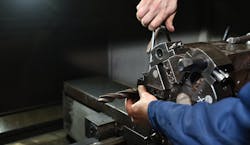Troubleshooting CNC Breakdowns and Steps to Avoid Them
When it comes to CNC machines, avoiding breakdowns is critical for a shop’s efficiency, cost, and overall production value. CNC machines are powerhouses that work at incredibly high speeds with tight tolerances while performing multiple tasks simultaneously and pumping out hundreds to thousands of perfect computer-generated parts. The process must be flawless from start to finish, and everywhere in between if the production run is to be usable - let alone perfect. If one fraction of an inch is miscalculated or a timing error somehow gets introduced, entire batches might become unusable in an instant.
Common breakdown causes. It’s essential for companies that provide CNC machine services to take a step back once in a while and inspect the actual machine to make sure things are well-oiled and operating well. As important as G-code and CAD programming are to the finished product, machine upkeep is just as critical. Here are several common breakdowns and, more important, ways to avoid them from occurring altogether.
Machine tool failures. CNC machines rely heavily on the tools they deploy to mill, cut, lathe, grind, and various other functions. These tools are critical to the success of every prototype and production run. In normal usage, tools accumulate dirt, dust, oil, and other debris. Eventually, this build-up can cause inaccuracies to occur in the production process, and if not taken addressed could lead to tool failures.
Machine tool failure is one of the easiest and simplest problems to address, but it can also be one of the most overlooked.
Loose fittings and vibrating parts. CNC machines get a lot of use - to put it mildly. They’re working hard all day long, executing thousands of maneuvers over the course of the day. While we typically expect our CNC machines to work well day after day with no operation errors, the movement itself could be a problem-causer.
When fittings become loose, they enter a vicious cycle. Because they’re loose, they’ll vibrate. Increased vibration then causes parts to become even looser. Unless something is done about it, the loose parts can become detached and cause the entire machine to malfunction. If not caught in time, this can be a problem not only for production runs but for the machine itself.
Heat build-up in the machine. Even though CNC machines are manufactured to withstand high heat, it can still be a problem if not closely monitored. The fast-moving parts and high-speed processes of a machine running for hours at a time will generate a tremendous amount of heat and friction. If temperatures rise too high within the machine, its performance may suffer as a result. If heat build-up becomes too great, high-pressure hoses on the inside can even melt.
Steps to avoid breakdowns. Fixing a breakdown is possible but it will cost time, revenue, and efficiency. Avoiding breakdowns will save your shop lost time and money and, over the long-run your machines will thank you for it.
Perform Regular Maintenance
The solution to avoiding machine tool failures is to follow a strict and regular protocol regarding machine maintenance. At a minimum, CNC machine operators should complete the following steps each day:
• Check fluid levels and top-up;
• Check all moving parts for dry spots and regrease where necessary;
• Wipe all surfaces to clear away dust, dirt, and small metal shavings prone to build-up.
Regularly examine the machine. Regular examination of your machine is the best way to avoid catastrophic failures that may result from loose fittings and vibrating parts. This examination should be done weekly, to keep things running tight and smooth.
Each week check:
• Electrical connection points;
• Hydraulic connection points;
• Pneumatic connection points; and,
• Mechanical connection points.
If any connection area in your machine consistently comes loose, report it to the CNC manufacturer. Simply by simply keeping an eye on your machine, you’ll discover potential problem areas before they become an issue.
Perform regular filter maintenance. Filter maintenance is key to ensuring good flow inside the machine. Better flow capacities mean air-cooled pipelines and heat-dissipating radiators work at peak performance. These are critical for keeping the temperature of a CNC machine down. The filters inside your CNC machine work in the same way as the AC filters in your home. If they get clogged with dirt, dust, metal shavings, and other debris, the clog will prevent efficient airflow. The less air flows through the machine, the more the internal temperature rises. Clogged filters are the enemy of CNC machine performance, and a major cause of overheating.
Doug Walker is a digital marketing specialist at Fictiv, a manufacturing platform for sourcing design and engineering teams, to streamline prototyping and accelerate product development. Contact him at [email protected]
About the Author
Doug Walker
digital marketing specialist
Doug Walker is a digital marketing specialist at Fictiv, a manufacturing platform for sourcing design and engineering teams, to streamline prototyping and accelerate product development. Contact him at [email protected]
